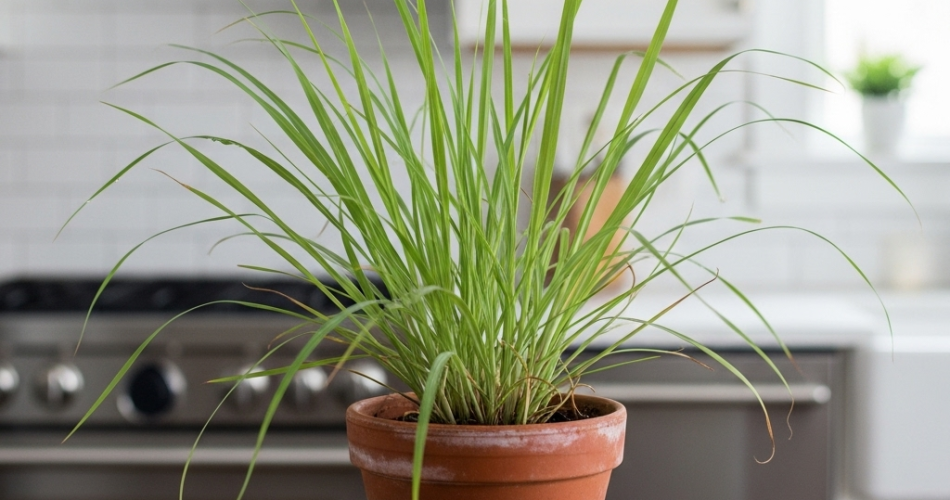Lemongrass is a fragrant and versatile herb, widely valued for its bright citrus aroma and culinary uses. From soups and curries to teas and marinades, fresh lemongrass adds a vibrant flavor that store-bought stalks often cannot match. While traditionally grown outdoors in tropical or subtropical climates, lemongrass can also thrive indoors. With a few simple techniques, anyone can grow fresh lemongrass in kitchen planters or containers, ensuring a year-round supply of this aromatic herb.
Choosing the Right Lemongrass
Successful indoor cultivation starts with selecting healthy stalks. Fresh stalks from grocery stores or nurseries with intact bases or small roots are ideal. Choose firm, vibrant green stalks with slightly swollen lower nodes, which indicate potential for new growth. Avoid wilted or dried-out stalks, as these are less likely to root successfully.
For best results, use stalks that have not been treated with pesticides or chemicals, ensuring organic growth and optimal flavor for cooking.
Preparing Containers for Indoor Growth
Lemongrass develops long roots and spreads as it grows, so choosing the right container is essential. A deep and wide pot, at least 12 inches in depth and diameter, provides enough room for root expansion. Ensure the container has drainage holes to prevent waterlogging, which can cause root rot. Terra cotta or ceramic planters are excellent choices, as they allow airflow and help regulate moisture levels, but any well-draining pot will work.
Soil Preparation
Lemongrass prefers loose, nutrient-rich, well-draining soil. A potting mix combining garden soil, compost, and sand or perlite creates an ideal medium for healthy root development. Avoid compacted or heavy soils that retain too much water. A slightly acidic to neutral pH of 6.0–7.0 is optimal. Mixing in a slow-release organic fertilizer at planting provides essential nutrients during early growth, promoting strong root and leaf development.
Planting Lemongrass Stalks
To plant lemongrass, trim the base of each stalk to leave about 3–4 inches, removing any dry or damaged outer layers. Insert the base into the soil, leaving the remaining leaves above the surface. If planting multiple stalks in one container, space them 2–3 inches apart to allow for growth and airflow. Water thoroughly after planting to help settle the soil around the roots.
Keep the soil consistently moist but avoid overwatering during the initial weeks, as excessive moisture can inhibit root formation.
Light and Temperature Requirements
Lemongrass thrives in bright, indirect sunlight. Place containers on a sunny kitchen counter or windowsill, ideally receiving at least 6–8 hours of light daily. If natural sunlight is insufficient, use a grow light to maintain healthy growth. Lemongrass prefers warm indoor temperatures between 70–85°F (21–29°C). Avoid areas with drafts, extreme temperature fluctuations, or proximity to heating vents, which can stress the plant.
Watering and Fertilization
Consistent watering is key for indoor lemongrass. Water when the top inch of soil feels dry, keeping the soil slightly moist but never soggy. Indoor containers dry out faster than garden beds, so monitor soil moisture regularly. Fertilize every 3–4 weeks with a balanced, water-soluble fertilizer to replenish nutrients that deplete in container soil.
Trim yellow or damaged leaves to maintain plant health and encourage new growth. Regular pruning also helps the plant stay manageable and prevents overcrowding.
Harvesting Lemongrass
Lemongrass can be harvested once stalks reach 12 inches or taller and have thickened bases. Cut stalks near the soil line, leaving some leaves intact for continued growth. Frequent harvesting stimulates new shoots, ensuring a steady supply of fresh stalks. Leaves can also be used in soups and teas, providing additional culinary uses.
Troubleshooting Common Challenges
Indoor lemongrass is generally hardy, but potential issues include overwatering, inadequate light, or pests such as aphids. Ensure proper drainage, provide sufficient light, and treat infestations promptly with organic solutions like neem oil or insecticidal soap. Maintaining these conditions promotes healthy growth and strong aromatic leaves.
Benefits of Growing Lemongrass Indoors
Growing lemongrass in kitchen containers offers convenience, freshness, and aesthetic appeal. It provides ready access to flavorful stalks for cooking, while its fragrance adds a pleasant aroma to indoor spaces. Indoor cultivation also allows gardeners to control soil and water quality, producing organic, pesticide-free herbs without the need for a backyard.
Conclusion
Fresh lemongrass grown in your kitchen combines practicality, flavor, and sustainability. By selecting healthy stalks, using well-draining soil, maintaining consistent watering, and providing adequate light, you can enjoy a thriving herb plant year-round. Indoor planters make it easy to grow lemongrass even in small spaces, turning your kitchen into a productive herb garden and offering a constant supply of aromatic stalks for culinary creations and beverages.



